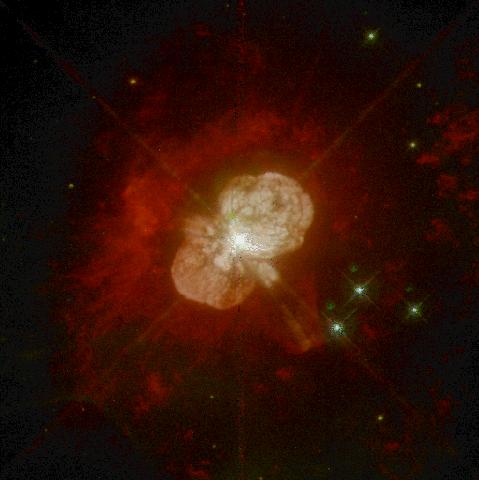Peculiar star
In astrophysics stars will (Latin peculiaris: particularly, peculiarly ) as Peculiar stars or Chemically Peculiar Stars as or shortly called CP stars that have unusual metal abundances, at least in their near-surface layer of their stellar atmosphere, the photosphere.
The discovery of chemically pekuliärer star goes to Antonia Maury, American astronomer from the Harvard College Observatory, back, the observed stellar spectra and published a catalog of stars classifications in 1897. They first discovered discrepancies in the spectra of some stars. The existence of strong magnetic fields in CP stars was founded in 1948 by Horace W. Babcock with the Zeeman effect. The first spectroscopic detection of CP stars in the Magellanic Clouds succeeded in 2010.
Survey
These hot Pekuliären stars were divided based on their spectra into 4 main classes, though sometimes only two classification systems are used:
The class name suggests the specifics of each class compared to the stars of the main sequence.
Properties
This chemical Pekuliären stars ( CP for short stars) are widespread among the hot wasserstofffusionierenden stars and belong to the main sequence. However, were also observed cool CP star ( spectral type G and later) as well as unusual compositions in carbon stars and stars of spectral type S.
Metal lines star
The Am stars ( CP1 stars) show only weak spectral lines of simple ionisertem Ca and / or Sc, but overabundances of heavy metals such as Zn, Sr, Zr and Ba. They tend to slow rotation speed, with effective temperatures between 7000 K and 10,000 K.
The Ap and Bp stars ( CP2 stars) typically have characteristic strong magnetic fields, overabundances of elements such as Si, Cr, Sr and Eu, as well as to Pr and Nd, and are in their majority also slowly rotating stars. The effective temperatures of this type is between 8,000 K and 15,000 K, where is the determination of the effective temperature generally in the Pekuliären stars, due to their complex atmospheric structures, difficult.
Mercury -manganese stars
The HgMn stars (CP3 stars) are also performed classic among the Ap stars, but do not have those strong magnetic fields like these. They show, as their name suggests, strong spectral lines of singly ionized mercury Hg and manganese Mn. They also have very slow rotation speed, even compared with the standard of the other types of CP stars. The effective temperature range is the mercury -manganese stars between 10,000 K and 15,000 K.
Helium star arms
The heliumamen stars ( CP4 stars) show significantly weaker He lines as one might have expected it by its classical photometry in the UBV Johnson system.
Summary
Basically, it is assumed that the specific surface compositions, which we observe in these CP stars, are only caused by processes after the star formation; This would on the one hand on the other hand, the diffusion induced by the magnetic field effects in the outer layers of the star atmospheres.
These processes cause some elements, particularly with He, N, and O, that they fall into the deeper layers of the star atmospheres, while other elements such as Mn, Sr, Y and Zr can be raised from the more central areas of the star upwards, then to the particular stellar spectra leads. It is assumed that the centers of these stars as the bulk of the remaining star also have completely normal frequencies of the elements. The frequencies, which also have the gas clouds from which they were originally based. For this frequency distribution and stratification by the processes mentioned for a long time remain stable, the atmospheres of these stars must itself remain stable enough so that no convection can occur, which in turn would become too strong the mixing in the star. And here could be the unusually strong magnetic field which can be observed in these types of stars, take the necessary stabilizing role.
However, there are also cooler stars ( spectral type G or later) with chemical peculiarities. These are not typically around main sequence stars. Usually these stars are then identified by their class name or other more detailed specifications. If of Chemical Pekuliären stars without additional further specifications is the speech, it is actually getting to the hot main sequence stars described hereinabove.
Many of the cooler CP stars are the result of a mixture of fusion products from the inner star field and its photosphere; this includes both the carbon stars as well as the stars of spectral type S with a. Others are the result of mass transfer in close binary systems; Examples are the Bariumsterne and some stars of spectral type S.
More
- Proper motion
- Doppler effect








